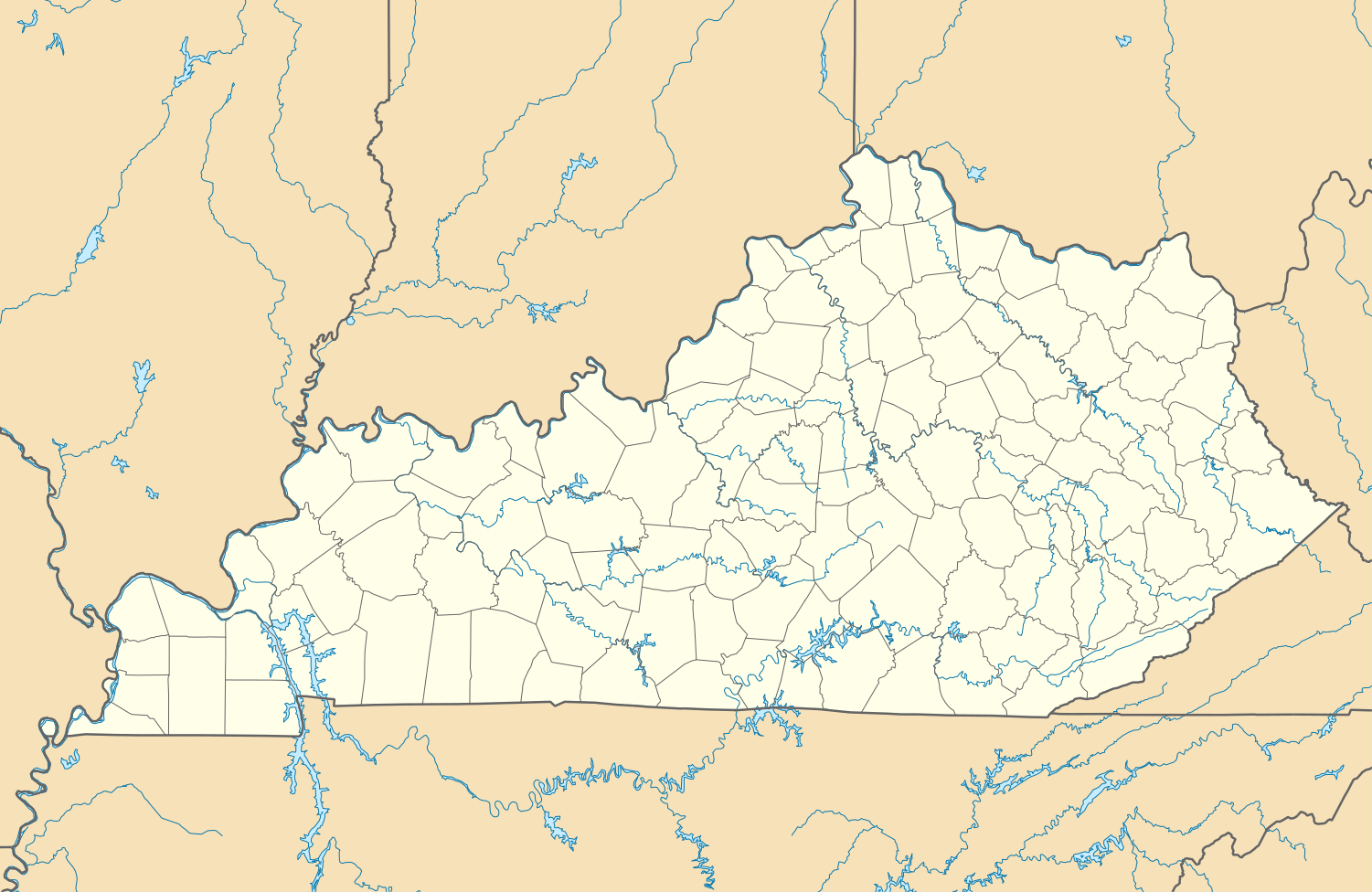Milton–Madison Bridge
| Milton–Madison Bridge | |
|---|---|
 Original Milton–Madison Bridge as seen from Milton, Kentucky | |
| Coordinates | 38°43′45″N 85°22′12″W / 38.729128°N 85.370114°WCoordinates: 38°43′45″N 85°22′12″W / 38.729128°N 85.370114°W |
| Carries |
2 lanes of |
| Crosses | Ohio River |
| Locale | Milton, Kentucky and Madison, Indiana |
| Other name(s) | Madison–Milton Bridge |
| Characteristics | |
| Total length | 3,184 feet (970 m) |
| Width |
20 feet (6.1 m) (original bridge) 40 feet (12 m) plus 5 feet (1.5 m) sidewalk (current bridge) |
| Longest span | 220 m |
| History | |
| Opened |
1929 (original bridge) 2014 (current bridge) |
| Statistics | |
| Daily traffic | 3,498/day |
| Toll | none |
 Milton–Madison Bridge Location in Kentucky | |
The Milton–Madison Bridge (also known as the Harrison Street Bridge) is a continuous truss bridge that connects Milton, Kentucky and Madison, Indiana. It carries approximately 10,000 cars a day.[1] The old structure was replaced with a completely new continuous truss which was constructed on temporary piers adjacent to the operational span between 2011 and 2012 and slid into place after demolition of the old span using a construction method called "truss sliding."[2] The new crossing opened to vehicle traffic in April 2014, and a pedestrian sidewalk opened that October.[3]
Description
This two lane vehicular bridge is the Ohio River crossing for U.S. Route 421. The bridge has a main span of 600 feet (180 m) and total length of 3,184.2 feet (970.5 m). The original bridge had a deck width of a mere 20 feet (6.1 m), and above the deck the vertical clearance was 16.8 feet (5.1 m). The new bridge has a 40-foot (12 m)-wide road bed, plus a 5-foot (1.5 m) cantilevered pedestrian-only path. Bicyclists are banned from the sidewalk, but may use the new bridge's 8-foot (2.4 m) shoulders.[3] This bridge is the only vehicular crossing of the Ohio River for 26 miles (42 km) going upstream (the Markland Bridge near Vevay, Indiana) and 46 miles (74 km) downstream (the Abraham Lincoln Bridge northbound and the John F. Kennedy Memorial Bridge southbound in Louisville).[4]
The bridge provides the shortest distance between Indianapolis, Indiana, and Lexington, Kentucky.[5]
History
Built by J.G. White Engineering Corp., construction was started in 1928, and completed in 1929, at the cost of $1,365,101.84. It was opened for traffic on December 20, 1929. Originally a toll bridge, on November 1, 1947 at noon the toll was removed.[5]
In 1997 the bridge was refurbished.[4] This was after a 1995 study which could not agree on a new bridge location, so $10 million was used for the refurbishment.[1]
Replacement
The bridge was replaced in the first half of the 2010s, as the original bridge was "functionally obsolete" and "structurally deficient."[6] It had a sufficiency rating of 33 out of a possible 100; its superstructure condition rating was considered "poor".[4] Modern trucks were unable to safely use the old bridge.[1] One of the boons of the new bridge would be to aid a $20 million "resort and entertainment center" where a cotton mill once stood.[7]
A Milton–Madison bridge study was begun by the Indiana Department of Transportation and Kentucky Transportation Cabinet on August 26, 2008. The study had to take in account the Madison Historic District, which is a National Historic Landmark, and the National Environmental Policy Act.[1]
The Indiana Department of Transportation (INDOT), in a partnership with the Kentucky Transportation Cabinet (KYTC), designed a new bridge to replace the original bridge. The new project was headed mostly by INDOT.[8] The bridge was removed except for several piers in the waterway, which were rehabilitated and widened to accommodate a new, wider steel-truss superstructure. Scour mitigation was also performed on the existing piers. The new bridge also features an ADA-compliant pedestrian walkway. Construction for the new bridge began in the fall of 2010, with the old bridge remaining open during work on the piers. Walsh Construction Company planned to close the bridge for only 10 days during construction rather than an anticipated year-long closure. The team used an innovative construction method called "truss sliding" to "slide" the 3,181-foot-long (970 m) truss into place along steel rails and plates.[9]
Emergency ferry service during the 2012 and 2014 bridge closure periods was provided by Madison, Indiana-based, Madison Milton Ferry LLC, in partnership with Anderson Ferry of Hebron, Kentucky.
The cost of the replacement was $103.7 million.[10]
Incidents
- On March 11, 2014, only four days before the truss slide was scheduled to begin, construction workers were installing a mechanism to facilitate the slide when a steel bearing on the southeast corner of the bridge dislodged, causing the bridge to drop by at least 1 foot (30 cm) and injuring one worker.[11] Work was conducted to replace the steel bearing ten days later and the bridge opened to traffic at 7:20 PM on April 17, 2014. The pedestrian path opened on October 30 of that year.
Gallery
| Wikimedia Commons has media related to Category:Milton-Madison Bridge. |
- Ironwork
- Internal ironwork
See also
-
 Bridges portal
Bridges portal -
 Kentucky portal
Kentucky portal -
 Indiana portal
Indiana portal - List of crossings of the Ohio River
References
- 1 2 3 4 "Kentucky officials announce kickoff of bridge study". Kentuckiana Publishing, Inc. September 2008. Retrieved 2009-01-30.
- ↑ "Milton–Madison bridge project milestones". Retrieved 2014-04-21.
- 1 2 "Madison, Milton Residents Enjoying New Sidewalk" (PDF) (Press release). Milton–Madison Bridge Project. October 30, 2014. Retrieved August 10, 2015.
- 1 2 3 Baughn, James (2002–2009). "Madison-Milton Bridge". Historic Bridges of the United States. Retrieved 2009-01-30.
- 1 2 "The Story of the Splendid Milton–Madison Bridge". nkyviews.com. Retrieved 2009-01-30.
- ↑ Weidenbener, Lesley (January 30, 2009). "Indiana panel may focus on Ohio River bridges". Courier-Journal. Retrieved 2009-01-30.
- ↑ "Indiana, Kentucky highway officials launch effort to build new Milton–Madison bridge". FOX 41 (Louisville). Retrieved 2009-01-30.
- ↑ http://transportation.ky.gov/contract/Memos/INDOT%20Design%20-%20Build.PDF
- ↑ "Milton–Madison Bridge Official Construction site". Retrieved 2011-02-05.
- ↑ "Raising Expectations", Bridge Design & Engineering, 28 August 2012, retrieved 8 August 2014
- ↑ Godfrey, Courtney (March 11, 2014). "No word on when Milton–Madison Bridge will reopen after accident". Louisville, Kentucky: WDRB. Retrieved March 12, 2014.
External links
- Official website of the construction project
- Milton–Madison Bridge at Bridges & Tunnels
- Madison–Milton Bridge at Historic Bridges of the United States